2016 MERCEDES-BENZ GLE snow chains
[x] Cancel search: snow chainsPage 240 of 450
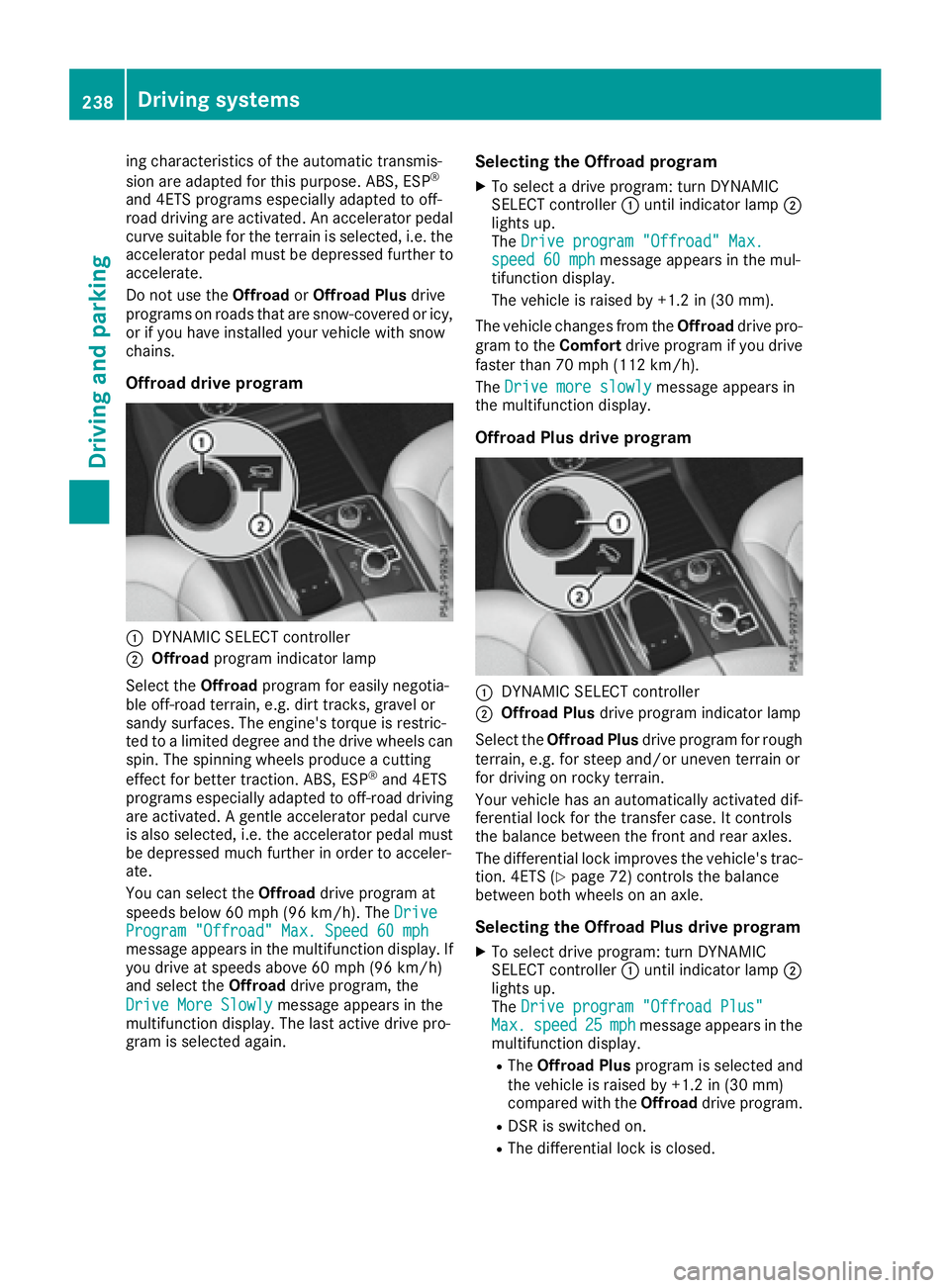
ing characteristics of the automatic transmis-
sion are adapted for this purpose. ABS, ESP ®
and 4ETS programs especially adapted to off-
road driving are activated. An accelerator pedal
curve suitable for the terrain is selected, i.e. the
accelerator pedal must be depressed further to
accelerate.
Do not use the Offroad or Offroad Plus drive
programs on roads that are snow-covered or icy,
or if you have installed your vehicle with snow
chains.
Offroad drive program
�C
DYNAMIC SELECT controller�D
Offroad program indicator lamp
Select the Offroad program for easily negotia-
ble off-road terrain, e.g. dirt tracks, gravel or
sandy surfaces. The engine's torque is restric-
ted to a limited degree and the drive wheels can
spin. The spinning wheels produce a cutting
effect for better traction. ABS, ESP ®
and 4ETS
programs especially adapted to off-road driving
are activated. A gentle accelerator pedal curve
is also selected, i.e. the accelerator pedal must
be depressed much further in order to acceler-
ate.
You can select the Offroad drive program at
speeds below 60 mph (96 km/h). The Drive
Program "Offroad" Max. Speed 60 mph
message appears in the multifunction display. If
you drive at speeds above 60 mph (96 km/h)
and select the Offroad drive program, the
Drive More Slowly message appears in the
multifunction display. The last active drive pro-
gram is selected again. Selecting the Offroad program X
To select a drive program: turn DYNAMIC
SELECT controller �C until indicator lamp �D
lights up.
The Drive program "Offroad" Max.
speed 60 mph message appears in the mul-
tifunction display.
The vehicle is raised by +1.2 in (30 mm).
The vehicle changes from the Offroad drive pro-
gram to the Comfort drive program if you drive
faster than 70 mph (112 km/h).
The Drive more slowly message appears in
the multifunction display.
Offroad Plus drive program
�C
DYNAMIC SELECT controller �D
Offroad Plus drive program indicator lamp
Select the Offroad Plus drive program for rough
terrain, e.g. for steep and/or uneven terrain or
for driving on rocky terrain.
Your vehicle has an automatically activated dif-
ferential lock for the transfer case. It controls
the balance between the front and rear axles.
The differential lock improves the vehicle's trac-
tion. 4ETS ( Y
page 72) controls the balance
between both wheels on an axle.
Selecting the Offroad Plus drive program X
To select drive program: turn DYNAMIC
SELECT controller �C until indicator lamp �D
lights up.
The Drive program "Offroad Plus"
Max. speed 25 mph message appears in the
multifunction display. R
The Offroad Plus program is selected and
the vehicle is raised by +1.2 in (30 mm)
compared with the Offroad drive program.R
DSR is switched on. R
The differential lock is closed.238
Driving systems
Driving and parking
Page 241 of 450
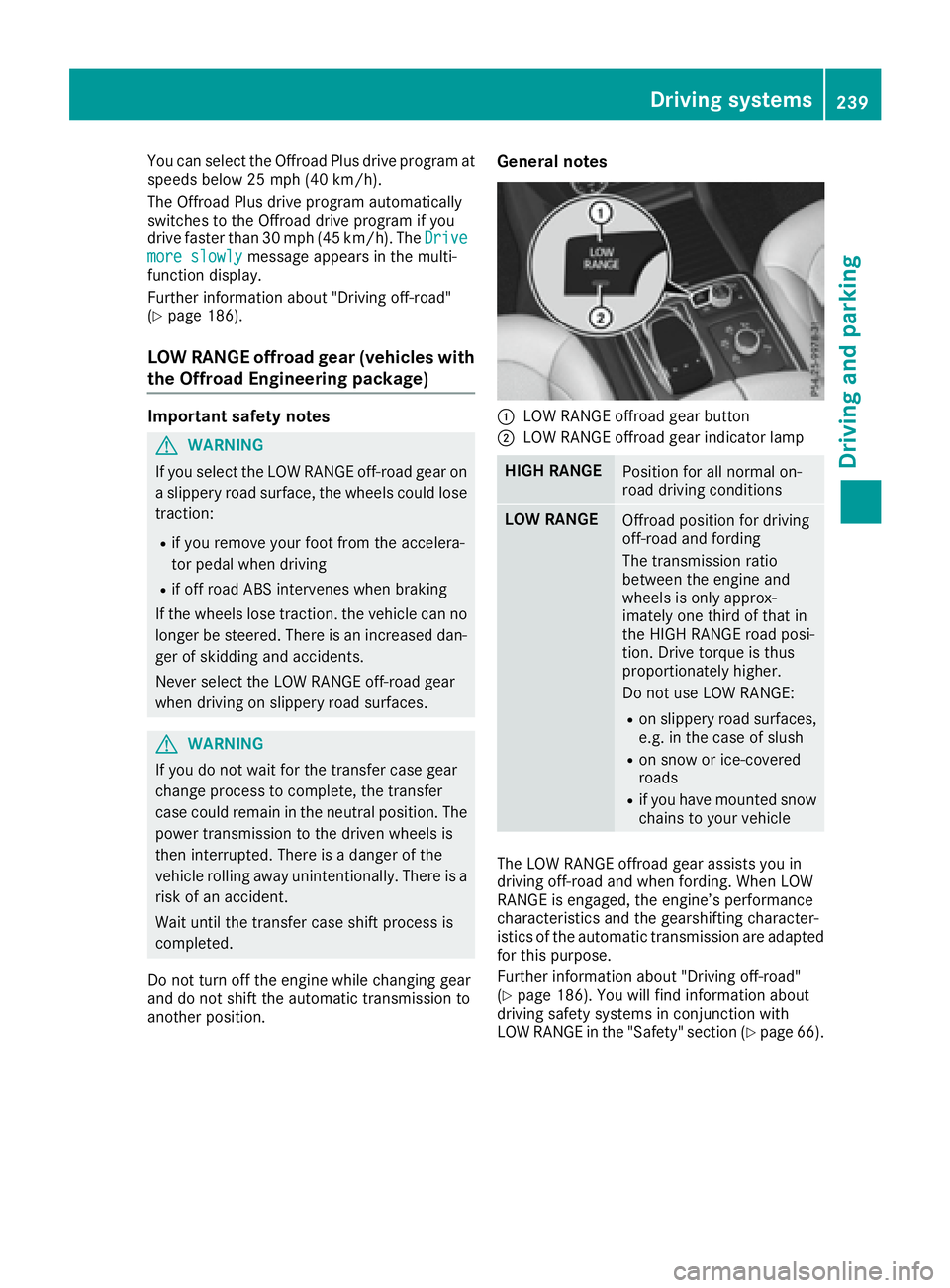
You can select the Offroad Plus drive program at
speeds below 25 mph (40 km/h).
The Offroad Plus drive program automatically
switches to the Offroad drive program if you
drive faster than 30 mph (45 km/h). The Drive
more slowly message appears in the multi-
function display.
Further information about "Driving off-road"
( Y
page 186).
LOW RANGE offroad gear (vehicles with
the Offroad Engineering package) Important safety notes
G WARNING
If you select the LOW RANGE off-road gear on
a slippery road surface, the wheels could lose
traction: R
if you remove your foot from the accelera-
tor pedal when driving R
if off road ABS intervenes when braking
If the wheels lose traction. the vehicle can no
longer be steered. There is an increased dan-
ger of skidding and accidents.
Never select the LOW RANGE off-road gear
when driving on slippery road surfaces.
G WARNING
If you do not wait for the transfer case gear
change process to complete, the transfer
case could remain in the neutral position. The
power transmission to the driven wheels is
then interrupted. There is a danger of the
vehicle rolling away unintentionally. There is a
risk of an accident.
Wait until the transfer case shift process is
completed.
Do not turn off the engine while changing gear
and do not shift the automatic transmission to
another position. General notes
�C
LOW RANGE offroad gear button �D
LOW RANGE offroad gear indicator lamp
HIGH RANGE
Position for all normal on-
road driving conditions
LOW RANGE
Offroad position for driving
off-road and fording
The transmission ratio
between the engine and
wheels is only approx-
imately one third of that in
the HIGH RANGE road posi-
tion. Drive torque is thus
proportionately higher.
Do not use LOW RANGE: R
on slippery road surfaces,
e.g. in the case of slush R
on snow or ice-covered
roads R
if you have mounted snow
chains to your vehicle
The LOW RANGE offroad gear assists you in
driving off-road and when fording. When LOW
RANGE is engaged, the engine’s performance
characteristics and the gearshifting character-
istics of the automatic transmission are adapted
for this purpose.
Further information about "Driving off-road"
( Y
page 186). You will find information about
driving safety systems in conjunction with
LOW RANGE in the "Safety" section ( Y
page 66).Driving systems 239
Driving and parking Z
Page 392 of 450
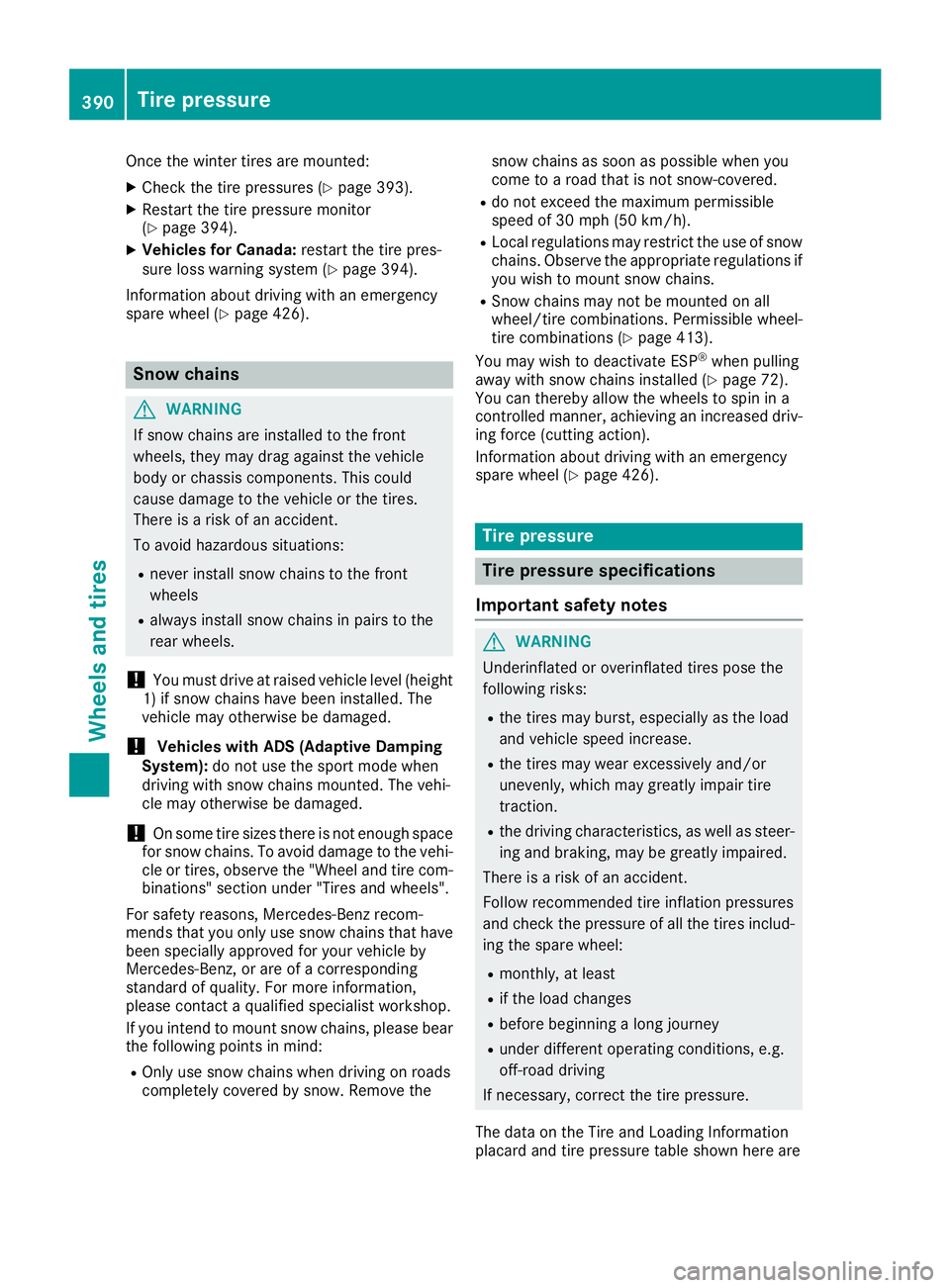
Once the winter tires are mounted: X
Check the tire pressures ( Y
page 393).X
Restart the tire pressure monitor
( Y
page 394).X
Vehicles for Canada: restart the tire pres-
sure loss warning system ( Y
page 394).
Information about driving with an emergency
spare wheel ( Y
page 426).
Snow chains
G WARNING
If snow chains are installed to the front
wheels, they may drag against the vehicle
body or chassis components. This could
cause damage to the vehicle or the tires.
There is a risk of an accident.
To avoid hazardous situations: R
never install snow chains to the front
wheels R
always install snow chains in pairs to the
rear wheels.
! You must drive at raised vehicle level (height
1) if snow chains have been installed. The
vehicle may otherwise be damaged.
! Vehicles with ADS (Adaptive Damping
System): do not use the sport mode when
driving with snow chains mounted. The vehi-
cle may otherwise be damaged.
! On some tire sizes there is not enough space
for snow chains. To avoid damage to the vehi-
cle or tires, observe the "Wheel and tire com-
binations" section under "Tires and wheels".
For safety reasons, Mercedes-Benz recom-
mends that you only use snow chains that have
been specially approved for your vehicle by
Mercedes-Benz, or are of a corresponding
standard of quality. For more information,
please contact a qualified specialist workshop.
If you intend to mount snow chains, please bear
the following points in mind: R
Only use snow chains when driving on roads
completely covered by snow. Remove the snow chains as soon as possible when you
come to a road that is not snow-covered. R
do not exceed the maximum permissible
speed of 30 mph (50 km/h). R
Local regulations may restrict the use of snow
chains. Observe the appropriate regulations if
you wish to mount snow chains. R
Snow chains may not be mounted on all
wheel/tire combinations. Permissible wheel-
tire combinations ( Y
page 413).
You may wish to deactivate ESP ®
when pulling
away with snow chains installed ( Y
page 72).
You can thereby allow the wheels to spin in a
controlled manner, achieving an increased driv-
ing force (cutting action).
Information about driving with an emergency
spare wheel ( Y
page 426).
Tire pressure
Tire pressure specifications
Important safety notes
G WARNING
Underinflated or overinflated tires pose the
following risks: R
the tires may burst, especially as the load
and vehicle speed increase. R
the tires may wear excessively and/or
unevenly, which may greatly impair tire
traction. R
the driving characteristics, as well as steer-
ing and braking, may be greatly impaired.
There is a risk of an accident.
Follow recommended tire inflation pressures
and check the pressure of all the tires includ-
ing the spare wheel: R
monthly, at least R
if the load changes R
before beginning a long journey R
under different operating conditions, e.g.
off-road driving
If necessary, correct the tire pressure.
The data on the Tire and Loading Information
placard and tire pressure table shown here are390
Tire pressure
Wheels and tires
Page 396 of 450
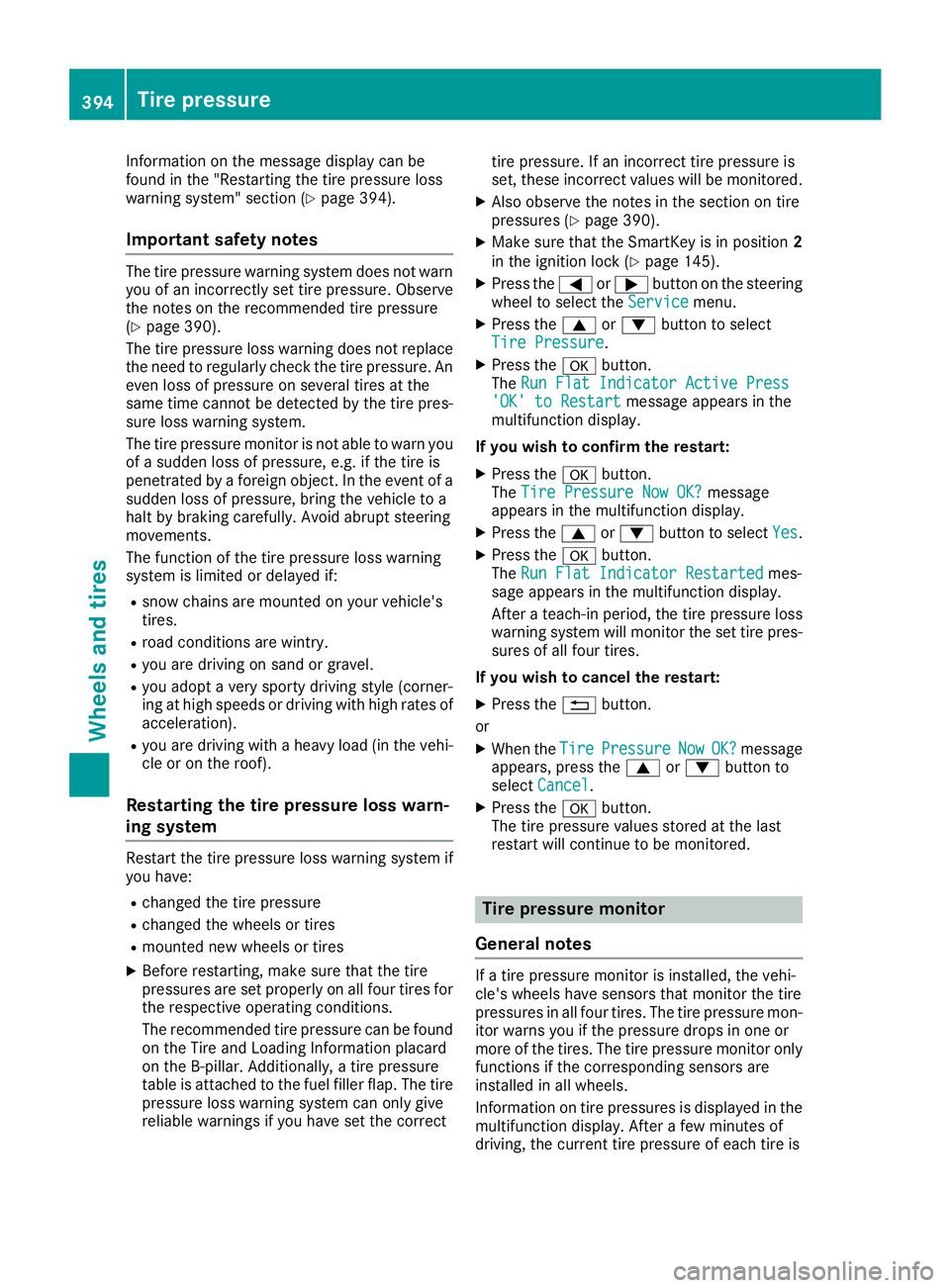
Information on the message display can be
found in the "Restarting the tire pressure loss
warning system" section ( Y
page 394).
Important safety notes The tire pressure warning system does not warn
you of an incorrectly set tire pressure. Observe
the notes on the recommended tire pressure
( Y
page 390).
The tire pressure loss warning does not replace
the need to regularly check the tire pressure. An
even loss of pressure on several tires at the
same time cannot be detected by the tire pres-
sure loss warning system.
The tire pressure monitor is not able to warn you
of a sudden loss of pressure, e.g. if the tire is
penetrated by a foreign object. In the event of a
sudden loss of pressure, bring the vehicle to a
halt by braking carefully. Avoid abrupt steering
movements.
The function of the tire pressure loss warning
system is limited or delayed if: R
snow chains are mounted on your vehicle's
tires. R
road conditions are wintry. R
you are driving on sand or gravel. R
you adopt a very sporty driving style (corner-
ing at high speeds or driving with high rates of
acceleration). R
you are driving with a heavy load (in the vehi-
cle or on the roof).
Restarting the tire pressure loss warn-
ing system Restart the tire pressure loss warning system if
you have: R
changed the tire pressure R
changed the wheels or tires R
mounted new wheels or tires X
Before restarting, make sure that the tire
pressures are set properly on all four tires for
the respective operating conditions.
The recommended tire pressure can be found
on the Tire and Loading Information placard
on the B-pillar. Additionally, a tire pressure
table is attached to the fuel filler flap. The tire
pressure loss warning system can only give
reliable warnings if you have set the correct tire pressure. If an incorrect tire pressure is
set, these incorrect values will be monitored. X
Also observe the notes in the section on tire
pressures ( Y
page 390). X
Make sure that the SmartKey is in position 2
in the ignition lock ( Y
page 145).X
Press the �Y or �e button on the steering
wheel to select the Service menu.X
Press the �c or �d button to select
Tire Pressure . X
Press the �v button.
The Run Flat Indicator Active Press
'OK' to Restart message appears in the
multifunction display.
If you wish to confirm the restart: X
Press the �v button.
The Tire Pressure Now OK? message
appears in the multifunction display. X
Press the �c or �d button to select Yes .X
Press the �v button.
The Run Flat Indicator Restarted mes-
sage appears in the multifunction display.
After a teach-in period, the tire pressure loss
warning system will monitor the set tire pres-
sures of all four tires.
If you wish to cancel the restart: X
Press the �8 button.
or X
When the Tire Pressure Now OK? message
appears, press the �c or �d button to
select Cancel . X
Press the �v button.
The tire pressure values stored at the last
restart will continue to be monitored.
Tire pressure monitor
General notes If a tire pressure monitor is installed, the vehi-
cle's wheels have sensors that monitor the tire
pressures in all four tires. The tire pressure mon-
itor warns you if the pressure drops in one or
more of the tires. The tire pressure monitor only
functions if the corresponding sensors are
installed in all wheels.
Information on tire pressures is displayed in the
multifunction display. After a few minutes of
driving, the current tire pressure of each tire is394
Tire pressure
Wheels and tires
Page 416 of 450
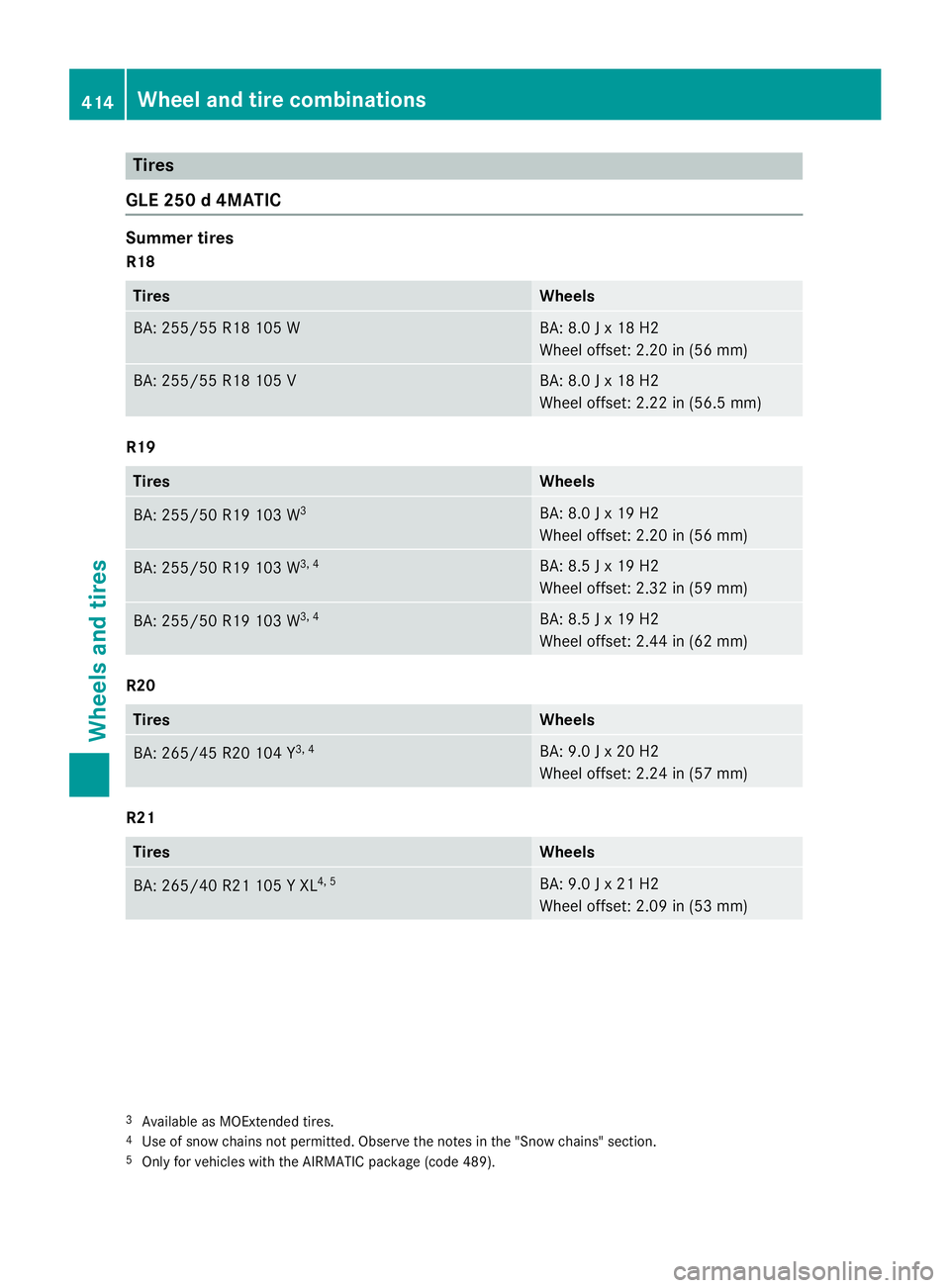
Tires
GLE 250 d 4MATIC Summer tires R18
Tires Wheels
BA: 255/55 R1 8 10 5 W BA: 8.0 J x 18 H2
Wheel offset: 2.20 in (56 mm)
BA: 255/55 R18 105 V BA: 8.0 J x 18 H2
Wheel offset: 2.22 in (56.5 mm)
R19
Tires Wheels
BA: 255/50 R19 103 W 3
BA: 8.0 J x 19 H2
Wheel offset: 2.20 in (56 mm)
BA: 255/50 R19 103 W 3, 4
BA: 8.5 J x 19 H2
Wheel offset: 2.32 in (59 mm)
BA: 255/50 R19 103 W 3, 4
BA: 8.5 J x 19 H2
Wheel offset: 2.44 in (62 mm)
R20
Tires Wheels
BA: 265/45 R20 104 Y 3, 4
BA: 9.0 J x 20 H2
Wheel offset: 2.24 in (57 mm)
R21
Tires Wheels
BA: 265/40 R21 105 Y XL 4, 5
BA: 9.0 J x 21 H2
Wheel offset: 2.09 in (53 mm)
3
Available as MOExtended tires. 4
Use of snow chains not permitted. Observe the notes in the "Snow chains" section. 5
Only for vehicles with the AIRMATIC package (code 489).414
Wheel and tire combinations
Wheels and tires
Page 417 of 450
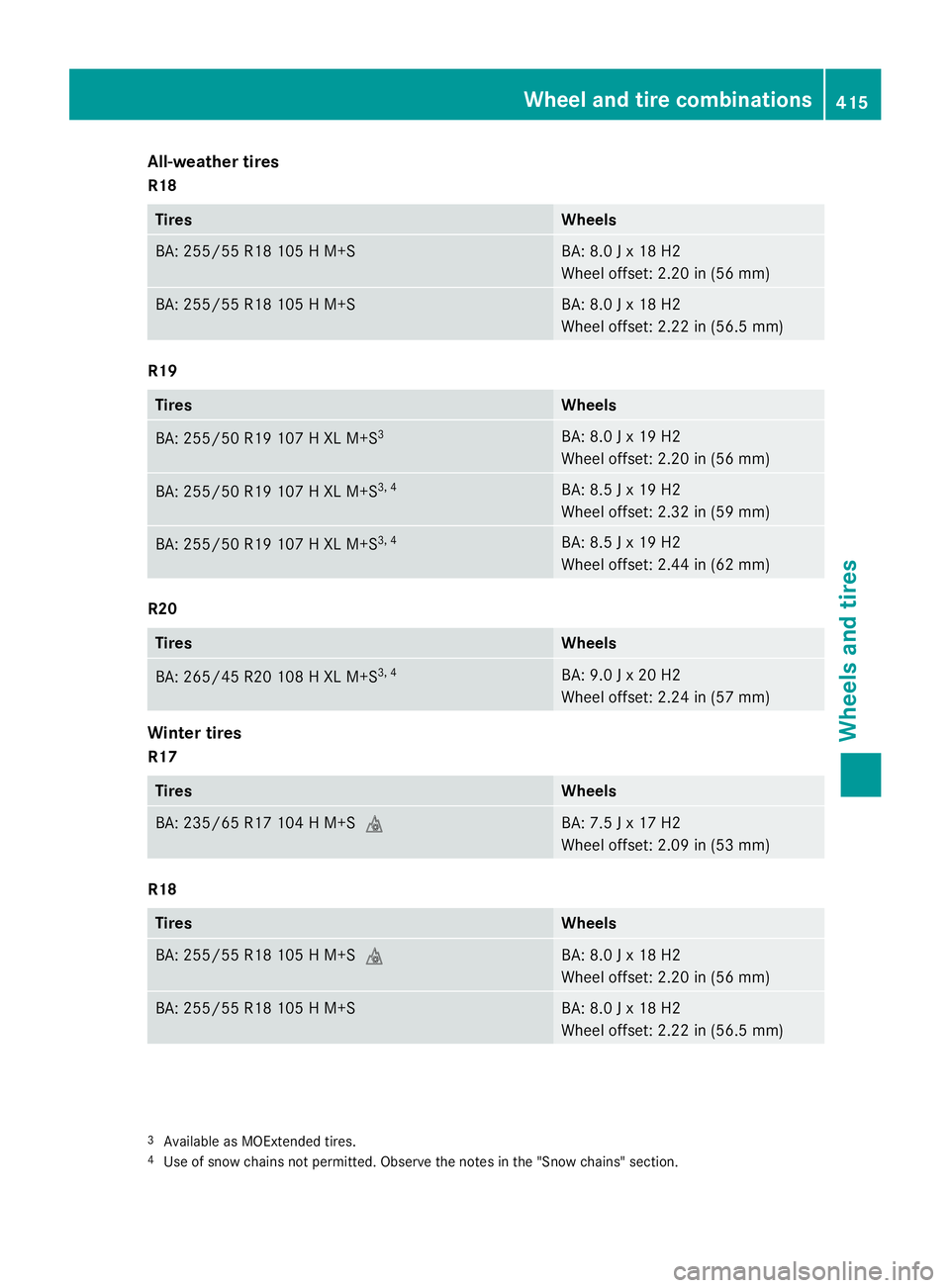
All-weather tires R18
Tires Wheels
BA : 255/55 R18 10 5 H M+S BA : 8. 0 J x 18 H2
Whee l offset : 2.20 in (56 mm)
BA : 255/55 R18 10 5 H M+S BA : 8. 0 J x 18 H2
Whee l offset : 2.22 in (56.5 mm)
R19
Tires Wheels
BA : 255/50 R19 10 7 H XL M+S 3
BA : 8. 0 J x 19 H2
Whee l offset : 2.20 in (56 mm)
BA : 255/50 R19 10 7 H XL M+S 3, 4
BA : 8. 5 J x 19 H2
Whee l offset : 2.32 in (59 mm)
BA : 255/50 R19 10 7 H XL M+S 3, 4
BA : 8. 5 J x 19 H2
Whee l offset : 2.44 in (62 mm)
R20
Tires Wheels
BA : 265/45 R20 10 8 H XL M+S 3, 4
BA : 9. 0 J x 20 H2
Whee l offset : 2.24 in (57 mm)
Winter tires R17
Tires Wheels
BA : 235/65 R17 10 4 H M+S �M BA : 7. 5 J x 17 H2
Whee l offset : 2.09 in (53 mm)
R18
Tires Wheels
BA : 255/55 R18 10 5 H M+S �M BA : 8. 0 J x 18 H2
Whee l offset : 2.20 in (56 mm)
BA : 255/55 R18 10 5 H M+S BA : 8. 0 J x 18 H2
Whee l offset : 2.22 in (56.5 mm)
3
Available as MOExtended tires. 4
Use of snow chain s no t permitted. Observ e th e note s in th e "Snow chains" section.Wheel and tire combinations 415
Wheels and tires Z
Page 418 of 450
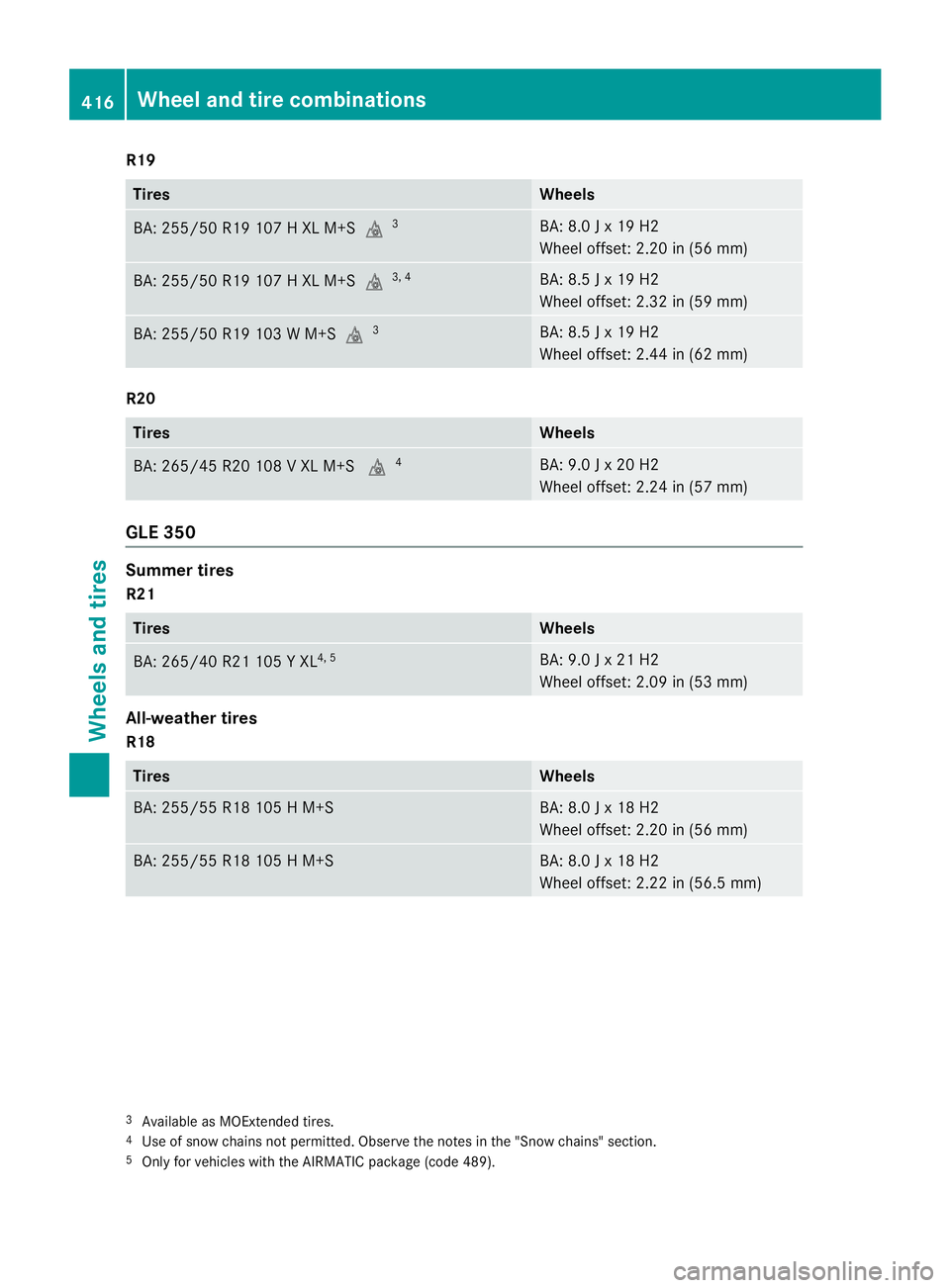
R19
Tires Wheels
BA: 255/50 R19 107 H XL M+S �M 3
BA: 8.0 J x 19 H2
Wheel offset: 2.20 in (56 mm)
BA: 255/50 R19 107 H XL M+S �M 3, 4
BA: 8.5 J x 19 H2
Wheel offset: 2.32 in (59 mm)
BA: 255/50 R19 103 W M+S �M 3
BA: 8.5 J x 19 H2
Wheel offset: 2.44 in (62 mm)
R20
Tires Wheels
BA: 265/45 R20 108 V XL M+S �M 4
BA: 9.0 J x 20 H2
Wheel offset: 2.24 in (57 mm)
GLE 350
Summer tires R21
Tires Wheels
BA: 265/40 R21 105 Y XL 4, 5
BA: 9.0 J x 21 H2
Wheel offset: 2.09 in (53 mm)
All-weather tires R18
Tires Wheels
BA: 255/55 R18 105 H M+S BA: 8.0 J x 18 H2
Wheel offset: 2.20 in (56 mm)
BA: 255/55 R18 105 H M+S BA: 8.0 J x 18 H2
Wheel offset: 2.22 in (56.5 mm)
3
Available as MOExtended tires. 4
Use of snow chains not permitted. Observe the notes in the "Snow chains" section. 5
Only for vehicles with the AIRMATIC package (code 489).416
Wheel and tire combinations
Wheels and tires
Page 419 of 450
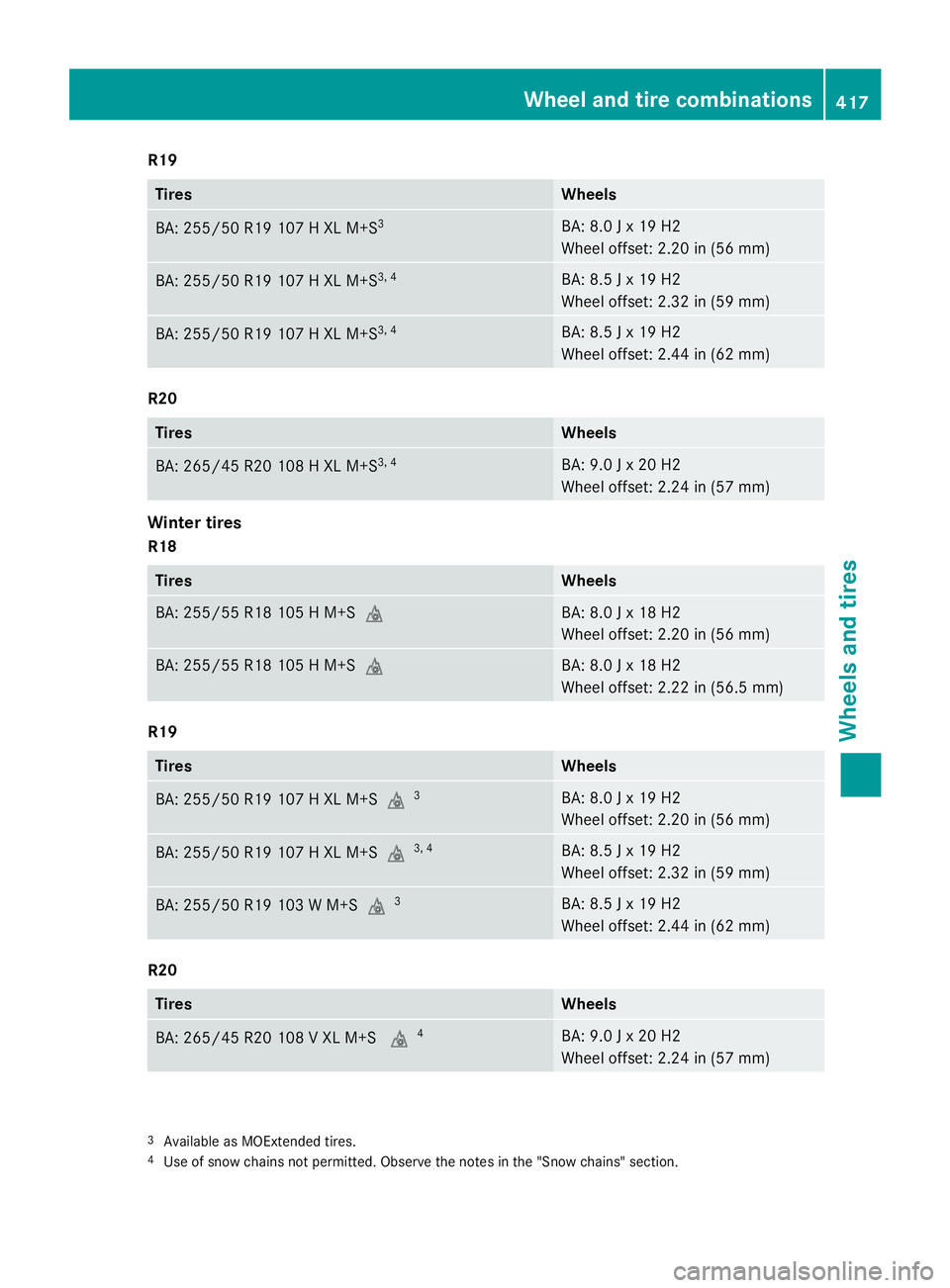
R19
Tires Wheels
BA: 255/50 R19 107 H XL M+S 3
BA: 8.0 J x 19 H2
Wheel offset: 2.20 in (56 mm)
BA: 255/50 R19 107 H XL M+S 3, 4
BA: 8.5 J x 19 H2
Wheel offset: 2.32 in (59 mm)
BA: 255/50 R19 107 H XL M+S 3, 4
BA: 8.5 J x 19 H2
Wheel offset: 2.44 in (62 mm)
R20
Tires Wheels
BA: 265/45 R20 108 H XL M+S 3, 4
BA: 9.0 J x 20 H2
Wheel offset: 2.24 in (57 mm)
Winter tires R18
Tires Wheels
BA: 255/55 R18 105 H M+S �M BA: 8.0 J x 18 H2
Wheel offset: 2.20 in (56 mm)
BA: 255/55 R18 105 H M+S �M BA: 8.0 J x 18 H2
Wheel offset: 2.22 in (56.5 mm)
R19
Tires Wheels
BA: 255/50 R19 107 H XL M+S �M 3
BA: 8.0 J x 19 H2
Wheel offset: 2.20 in (56 mm)
BA: 255/50 R19 107 H XL M+S �M 3, 4
BA: 8.5 J x 19 H2
Wheel offset: 2.32 in (59 mm)
BA: 255/50 R19 103 W M+S �M 3
BA: 8.5 J x 19 H2
Wheel offset: 2.44 in (62 mm)
R20
Tires Wheels
BA: 265/45 R20 108 V XL M+S �M 4
BA: 9.0 J x 20 H2
Wheel offset: 2.24 in (57 mm)
3
Available as MOExtended tires. 4
Use of snow chains not permitted. Observe the notes in the "Snow chains" section. Wheel and tire combinations 417
Wheels and tires Z